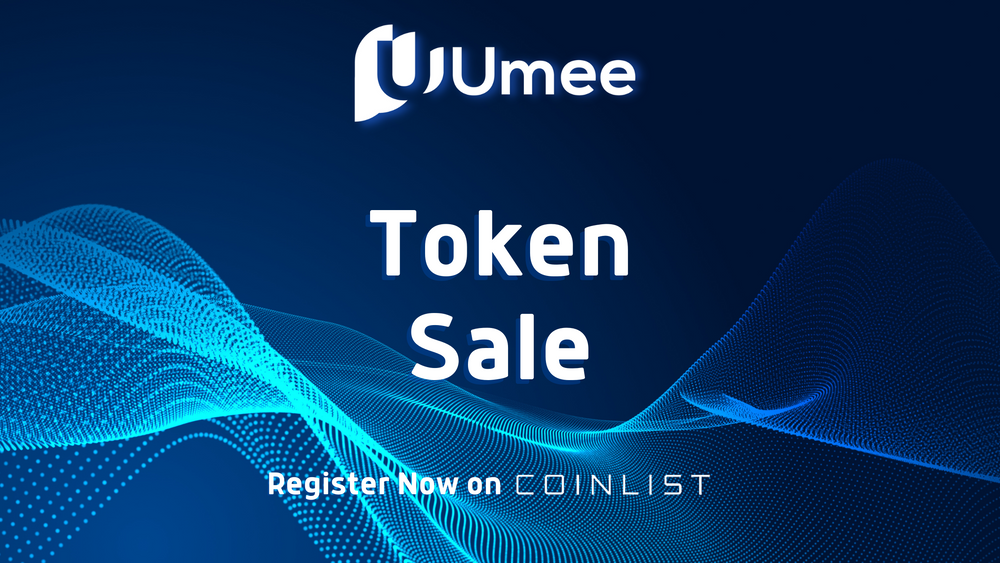Umee is the decentralized infrastructure for cross chain interactions between networks. Umee connects users to create lending and borrowing positions, move capital across chains, discover new yield opportunities and explore DeFi applications in a seamless and trustless manner.
Umee (UMEE) Token Sale Whitelist on CoinList
To register the whitelist, you should REGISTER COINLIST ACCOUNT HERE.
The sale begins on December 1, 17:00 UTC and has two public options:
Option 1
- Supply: 300,000,000
- Price: $0.06
- Lockup & release: 2-month cliff followed by a 10-month linear vesting schedule, with tokens released on or around February 15, 2022
- Link to register: https://coinlist.co/umee-option-1/onboarding
Option 2
- Supply: 200,000,000
- Price: $0.07
- Lockup & release: 2-month cliff followed by an 8-month linear vesting schedule, with tokens released on or around February 15, 2022
- Link to register: https://coinlist.co/umee-option-2/onboarding
The Umee Blockchain – The Cross Chain DeFi Hub
Umee is a cross chain DeFi hub that interconnects between blockchains. As a base layer DeFi protocol, an ecosystem of applications can be built on top of Umee. The Umee Blockchain facilitates instant interoperability using the Tendermint Proof of Stake consensus protocol with the Cosmos ecosystem, Ethereum network, side chain architectures, layer 2 scaling solutions, and alternative base layer protocols.
A few reasons why we’re excited about Umee:
- A Base Layer DeFi Hub – The Umee Blockchain is built on the Cosmos SDK and Ethereum Virtual Machine for interconnecting between DeFi and lending specific use cases. Umee offers a flexible mix of speed and efficiency for blockchain transactions using a fast finality consensus protocol based on Tendermint Proof of Stake.
- Proof of Stake Meets the Global Debt Markets – The initial product built on top of Umee will be cross chain borrowing and lending as well as the building blocks for onboarding global debt into DeFi. By creating tools for allowing new leverage components and interest rates, Umee is onboarding new markets and ecosystems into crypto and becoming the leverage facility for the blockchain world.
- Cross Chain Interoperability – The vision of Umee is to spearhead the development of a multi-chain world and serve as a cornerstone to the overall blockchain ecosystem. Umee uses IBC (Inter-Blockchain Communication) which is the flagship Cosmos protocol for cross chain communication.
Umee Compatible Networks

UMEE Tokenomics
UMEE is the native Proof of Stake token of the Umee Blockchain. Blockchain participants use the token to pay for computation fees and to reward validators for providing Tendermint BFT consensus towards processing network transactions. The token is also a governance token for making decisions about the protocol configurations of Umee, parameters of the DeFi applications, as well as product and program proposals.
The UMEE token will exist as both a Cosmos SDK based token as well as a native ERC-20 token.
Token Distribution
| Segment | Total Supply in % | Release Schedule |
| Community | 46% | Umee governance decides on the distribution plans through community incentive and grant programs; 6 years vesting |
| Ecosystem | 9% | Umee governance decides on the distribution plans through ecosystem programs; 8 years vesting |
| Team | 25% | 36 month lockup: 6 month cliff (no vesting) starting on or around Feb 15th 2022, followed by 30 month linear vesting |
| Advisors | 1% | 36 month lockup: 6 month cliff (no vesting) starting on or around Feb 15th 2022, followed by 30 month linear vesting |
| Seed Round | 13% | 24 month lockup: 6 month cliff (no vesting) starting on or around Feb 15th 2022, followed by 18 month linear vesting |
| Public Sale | 5% | See sales structure above |
| Strategic Round | 1% | 12 month lockup: 6 month cliff (no vesting) starting on or around Feb 15th 2022, followed by 6 month linear vesting |
Token Use Cases
Validator Infrastructure
The Umee Blockchain is built on a network of validators that contribute Tendermint BFT consensus to the protocol. Tokens are bonded to validators that stake to provide Proof of Stake to the network. Validators come from an open ecosystem of contributors and infrastructure providers. Tokens can also be delegated to validators by users to participate in the underlying consensus mechanism.
Network Fees and Proof Of Stake Consensus
Network fees will be earned in the form of UMEE tokens by validator infrastructure providers. Similar to how ETH is used as a gas fee to pay for transactions on the Ethereum blockchain, UMEE is used as a gas fee to pay for transactions on the Umee Blockchain. Validators earn block rewards in the form of UMEE similar to how transaction fees are processed in native blockchain protocols.
Protocol Governance
The native UMEE token is also a protocol governance token used to facilitate on-chain governance for the Umee Blockchain. The governance token can be used to vote on configurations of the protocol as well as network upgrades for improving functionality of the blockchain infrastructure. The UMEE governance token will additionally govern DeFi parameters of applications that sit on top of the Umee base layer DeFi protocol.

